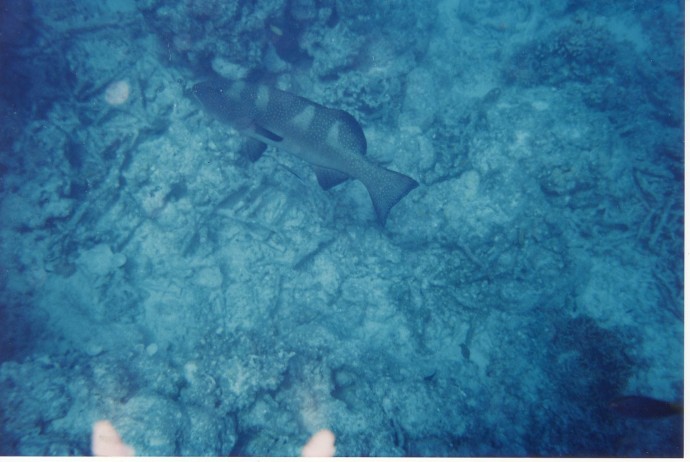Bluespot coral trout
Introduction to bluespot coral trout and why it is important
The bluespot coral trout (Plectropomus laevis) is the largest of coral trout species and are common in east coast waters including Torres Strait and into southeast Queensland. They are an iconic and popular target species for all fishery sectors, though relatively less common than their congener species. They display distinct differences in abundance across the continental shelf of eastern Queensland and are most common on outer-shelf reefs (Newman et al 1997). They come in two colour forms; the more usual dark brown-red body colour with large blue spots (blue spot form) and the less common ‘footballer’ form characterised by a white body with black saddles, yellow fin markings and fewer blue spots. Larger individuals tend to show the blue spot form (Heupel et al 2010). They are the most common coral trout species encountered on Coral Sea reefs from where they are often reported to be the cause of ciguatera poisoning.
Key concepts that relate to connectivity
The life history of blue spot coral trout is poorly studied compared to other coral trout species. Heupel et al (2010) provide the only demographic study highlighting their larger size at sex change meaning they require separate management from other coral trouts. They are reported anecdotally to aggregate to spawn like other serranid species, though not in the same quantity. Their life cycle is therefore assumed to be similar to common coral trout but with faster growth in order to reach the larger sizes attained at similar ages (Heupel et al 2010).
The stock structure of blue spot coral trout has not been studied, and unlike other coral trout species there are significant populations of P. laevis on Coral Sea reefs. Therefore the connectivity of bluespot coral trout between the Coral Sea and other adjacent jurisdictions on the Australian mainland is uncertain, however is assumed likely to occur through larval dispersal at least. Research is needed to test this assumption.
References
Heupel, M.R., Williams, A.J., Welch, D.J., Davies, C.R., Adams, S., Carlos, G. and Mapstone, B.D. (2010) Demography of a large exploited grouper, Plectropomus laevis: Implications for fisheries management. Marine and Freshwater Research, 61: 184-195.
Newman, S.J., Williams, D. McB. And Russ, G.R. (1997) Patterns of zonation of assemblages of the Lutjanidae, Lethrinidae, and Serranidae (Epinephelinae) within and among midBshelf and outerBshelf reefs in the central Great Barrier Reef. Marine and Freshwater Research, 48: 119B128.







